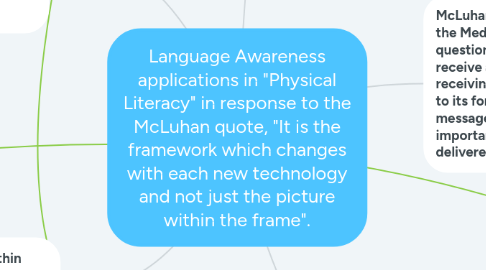
1. There is a discourse within literature that inaccurately defines physical literacy as the ability to perform fundamental movement skills.
1.1. This is an example of a failed professional development intervention where there was a missed opportunity to positively change the framework of teaching physical education
1.1.1. There are often conflicts between the demands of summative assessment and the objectives behind physical literacy (Lundvall, 2015)
1.1.1.1. The CALP website is funded by the government of Canada and very simply lays out its information on physical literacy to a variety of audiences: students, teachers, and parents. Using tools like this will allow me to ensure that I do not forget to assess the importance concepts within physical literacy
2. Physical literacy's role in the physical education discourse can be likened to a tool that helps organize the thinking/understanding of the holistic individual's practice of learning and performing in a variety of setting.
2.1. Historically, due to the lack of shared philosophies within the profession of physical education there has been a lack of cohesion and a shared curricular approach (Marshden and Weston, 2007)
3. Definition of Language Awareness: "Explicit knowledge about language, and conscious perception and sensitivity in language use" (Association for Language Awareness, 2015)
3.1. An attention to the sensitivity of physical literacy language is key to its lasting adoption and changing of pedagogical frameworks.
3.1.1. There continues to be a need for the creation of both professional and common language relating to physical literacy. Within the professional community proper language better allows for the discussion and embodiment of qualities relating to physical literacy. The development of this language has been and continues to be an ongoing process. The lack of common language is a hindrance to the communication of results to assessment in practice. Without proper language, physical educators risk becoming confused and resorting back to traditional quantitative sport-skill based assessments (Lundvall, 2015).
4. Definition of Physical Literacy: The motivation, confidence, physical competence, knowledge and understanding to value and take responsibility for engagement in physical activities for life. (IPLA,2017)
4.1. Numerous positives for both educators and students are observed when teaching occurs through a physical literacy lens. This change of teaching lens can be considered a shift in framework.
4.1.1. Canada's Physical Literacy Consesus Statement indicates Four Essential and Interconnected Elements to target when teaching for physical literacy.
4.1.1.1. Motivation and Confidence (Affective)
4.1.1.2. Physical Competence (Physical)
4.1.1.3. Knowledge and Understanding (Cognitive)
4.1.1.4. Engagement in Physical Activities of Life (Behavioural)
5. McLuhan's paradoxical statement the Medium is the Massage questions whether when you a receive a message you are receiving the content as opposed to its form. He argues that how a message is delivered is more important that what is being delivered.
5.1. In the physical education physical literacy focuses more on "why" we are taught specific skills, then on "how" we are taught them.
5.1.1. Eg. There is an important difference between throwing a football to learn how to become a quarterback and learning the overhand throw technique such that it can be applied to a variety of territory invasion style throwing games.
5.1.1.1. Teaching the throwing of the football targets predominantly the physical domain and misses an opportunity for the application to the cognitive and affect side of physical education
5.1.1.2. Teaching from a physical literacy perspective involves shifting the framework of your lesson plans. It cannot be done at the discrete skill level. It is a holistic concept.
